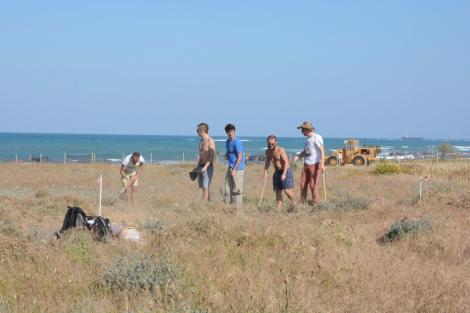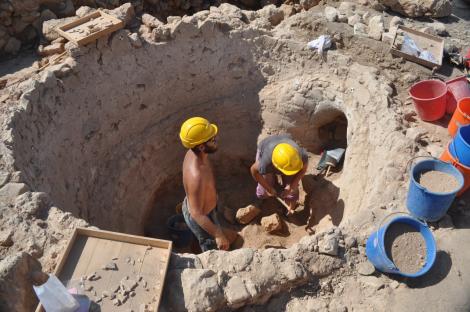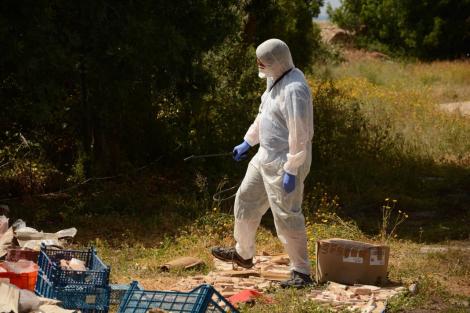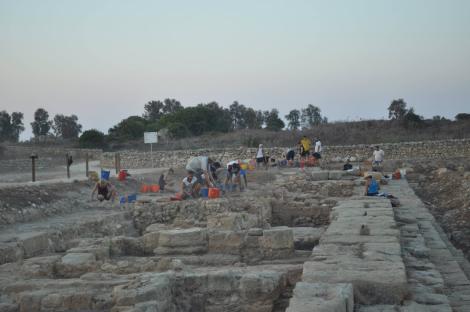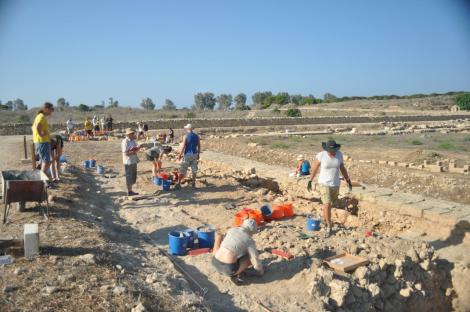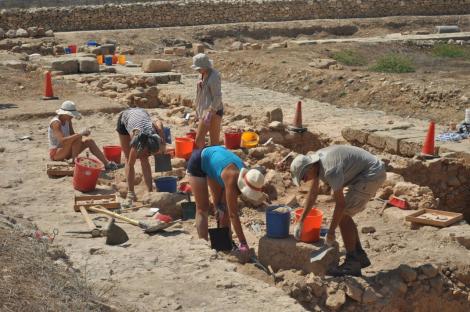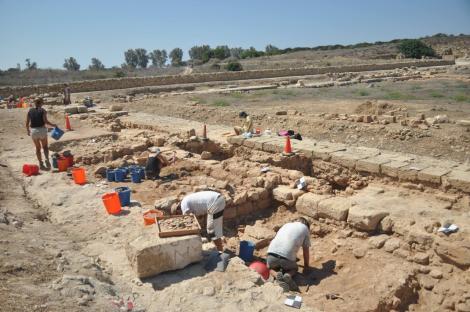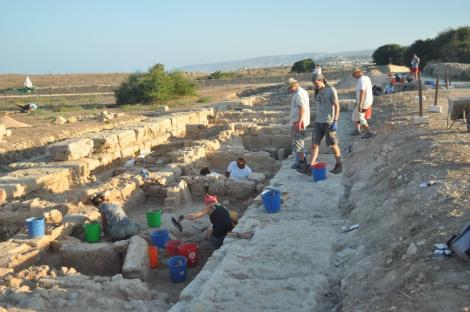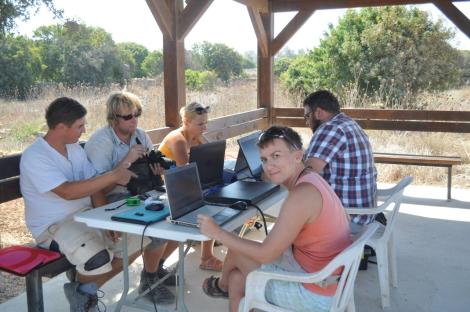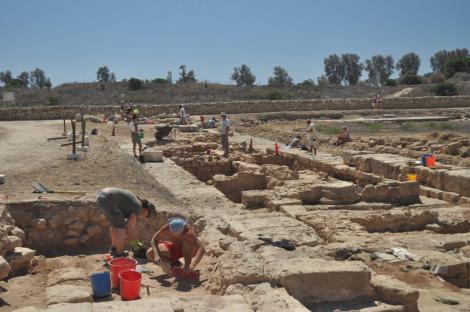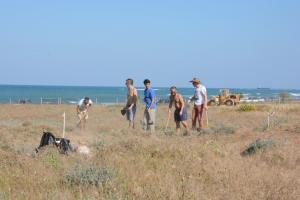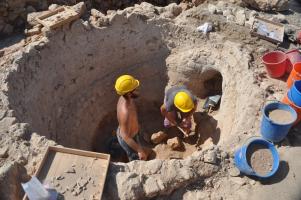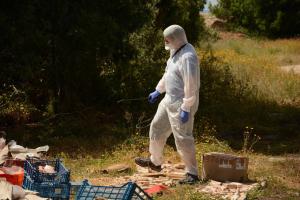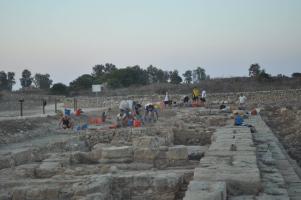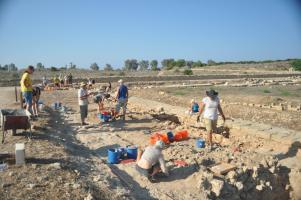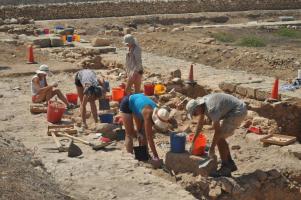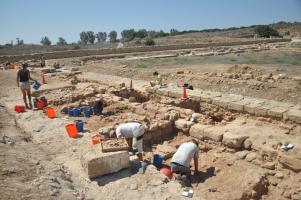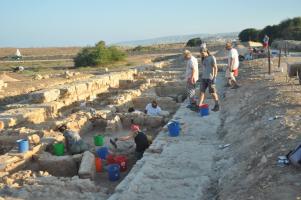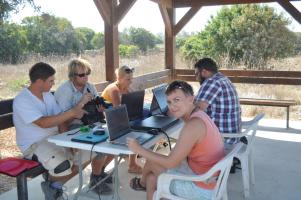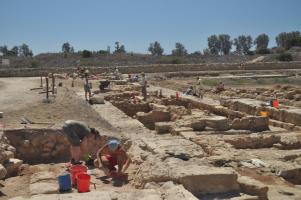Firstly, a two month’s study campaign during April and May took place, having as its main aim, the study of the material excavated in the previous years. The documentation, description, drawings, photos etc. were done in order to prepare the studied material for our publication (the first volume of the new series, Paphos Agora Project). The second aim of the spring season was the continuation of the verification of the hypothesis claiming that the second harbour of Paphos could have operated at the NW bay, close to the NW city gate. The geophysical, non-invasive prospection done there in 2016, showed two large rectangular interferences which were interpreted as buildings, as well as some linear structures: all potentially linked with the hypothetical harbour. Based on these observations, three Trial Trenches (TT) were delineated with the aim of verifying the magnetic research results. Only two of them were partly excavated during the spring season. The TTIV was traced just north of the N city wall because of circular interference seen in the magnetic prospection, but not excavated in spring (see below). Aerial photos were also taken with the use of an UAV (popularly called a drone), as well as some preservation works on the terrain and on some selected objects of material culture (pottery).
The main campaign took place during the late summer and early autumn. It comprised the inventarisation, excavation works, geophysics, geoarchaeology, preservation of metal objects and the preservation of various features on the site, as well as the promotion of the project. The excavation season lasted from the 25th of August until the 4th of October. After this period was completed, the promotional events took place and following these, many of the expedition's members participated in a conference devoted to Nea Paphos and the region.
Before the main campaign, the AGH University of Science and Technology in Kraków’s team (project BARI XVI) of students and staff in collaboration with the Paphos Agora Project had completed the inventarisation of the architectonic details, as well as of the selected pottery excavated in the Agora, the non-invasive measurements on the Agora and details of the other places accessible for the tourists in the Archaeological site of Kato Paphos.
Excavations were conducted in the Agora itself and in the Trial Trenches reported above. In the Agora, Trenches II and IV were explored. In T.II, the exploration was done in southern part of the East Portico in R.14 (partly excavated in previous years) and in the newly uncovered, R.20, with an area of almost 13 sq. m. Undoubtedly, the most interesting finding in R.20 was the fragment of a monumental limestone block, probably part of the architrave, with a partially preserved (only four letters) Latin inscription. It is not possible to draw any conclusion from it, but the ashlar comes without doubt from a large public building (or monument) and the inscription was done carefully and accurately. The research of 2017 and the preliminary studies on the excavated movable material confirm the statements about the Hellenistic date of the Eastern Portico and the date of its last phase to the 1st half of the 2nd century AD made by the JU research team.
Another area which was excavated in T.II is situated in the axis of the eastern entrance to the Agora. The main objective of the research was to determine whether the portico continues to the east with a third row of rooms or corridors, or maybe whether the street should flank the East Portico from this site. A continuation of the large drainage sewer, S.153, was found with four, big slabs covering it. In the debris layer above it, two fragments of partly preserved Greek inscriptions incised on marble slabs were found. One of them is accompanied by the depiction of an ivy leaf that suggests the Dionysiac context. In the southern part of the excavation, a complex water management system consisting of two interconnected pools and a pipe was uncovered. The pools had been covered with hydraulic mortar on bedding, constructed from fragments of carefully selected roof tiles. The system was partly destroyed when the walls collapsed. It cannot be excluded that this newly uncovered system was connected with the sewer, S.153, the system of the pool, canalisation and the well uncovered in R.8, but this topic requires further study.
The third area excavated in T. II was the well (or cistern), S.117, already found in 2011 and situated in the square inside the Agora, west from the entrance, on the axis of sewer S.153. The aim of this exploration was the establishment of the chronology of this object, as well as its relation to S.153. In the upper part, the filling of the well was dry and consisted of stones and blocks and some ceramic material. In the lower part, there was much more ceramic material, but it was very crushed and very wet, immersed in dense clay soil. Two very well-preserved dice (gaming pieces) made of bone were also discovered. The well was almost 6m deep. The preliminary analysis of the ceramic material showed that the well was functioning during the first half of the 2nd century AD.
The last area to be excavated in the Agora itself was Trench IV. In R.30, the exploration of a pit was continued, situated at the western boundary of the trench. It was probably an oven for the melting of metal. It was dug into the earth and functioned in the first phase of the utilisation of this area, which was during the reign of Emperor Augustus when this area formed one complete space (later, probably in the second half of the 1st century AD, it was divided into two rooms, labelled Room 30 and 31).
During the main campaign of the excavations, the continuation of works in Trial Trenches was also done. In TT I inter alia, a grave built of blocks and stones and partly dug into rock had already been discovered during the spring study season (which in magnetic picture was interpreted as part of a corner of large building). The decision was taken to cover it with earth and sand after exploration with the aim of protecting it. In TT II, delineated and partly excavated in the spring (and which was extended a little during the summer season), three stages of use were detected. Firstly, this area was used as a quarry, then some occupation activity took place (the excavation exposed walls and cultural layers) which has preliminarily been dated to the first half of the 2nd c. AD. And finally, this area (including TT I) was used as a necropolis, probably in Late Roman and Byzantine times. In TT III, situated close to the western wall and NW gate of the city, the exploration did not reveal the expected remains of a building, but the exploration here has not been finished. The work moved very slowly due to the very compact and extremely hard layer of soil in this place. Extremely interesting results have been obtained in TT IV, where the magnetometer prospection showed a regular circular feature connected most likely with the use of fire. It was confirmed by the discovery of a furnace, probably used to obtain quicklime from blocks, stones and objects made of lime and possibly dated to the Late Roman or Byzantine period. The lime kiln has the shape of an almost perfect circle in the plan, the upper preserved part, had a diameter of 2.60m on the N-S axis and 2.75m on the W-E axis. Next to the kiln, in the western part of the excavation, the NE-SW wall was also revealed . The exploration will be continued in 2018 with the aim of clarifying the chronology of the object, as well as the interpretation of the wall. It should be emphasised here that the results of research from TT.IV almost perfectly coincide with the results of the geophysical prospection, which bodes well for the future regarding the possibility of using of the magnetic method in the registration of objects related to thermal treatment.
As in previous years, the geophysical prospection was continued, but during this year’s campaign not only a magnetometer, but also Ground Penetrating Radar (GPR) was used. The chief objective was to detect the economic infrastructure of the city. It was planned that this year, the works would be done in the central and eastern part of the Archaeological site (so called Archaeological Park). In the field, however, the planned working schedule for the magnetic mapping had to be discarded, as the topographical and vegetative conditions on the ground were difficult and due to the present ecological protection status of the archaeological site, no extensive cleaning work could be carried out. Finally, a total of more than 11 hectares was mapped using the magnetometer in various easily accessible parts of the Archaeological site. Work with the GPR focused on the Agora to achieve more detailed data in comparison to the geomagnetic research done here in 2015 and 2016. Additionally, the modern parking lot near the Agora and a small area on the acropolis (Fanari Hill) were also prospected with the GPR. A total area of about 2 hectares have been prospected by GPR during the 2017 campaign.
The preliminary results of the magnetic mapping led to a conglomerate of various remains scattered throughout the park. At first glance, an interpretation seems to be difficult because of the high density of anomalies (mainly modern), but it could be resolved by the overall context. One of the most important results is the detailed recording of the ancient road grid, which also appeared in the results from the year 2016. Now, all data will be processed with the aim of obtaining detailed results and interpretations.
As a preliminary result of GPR, a dense architectural development in the southeast of the Agora was apparent. The northern part of the Portico and its N-E corner could be followed as well. Finally, it is important to draw attention to another wall that follows a north-south axis, approximately in the middle of the square and is interpreted as a possible predecessor to the later Agora. On the whole, the GPR provided far more differentiated results on the Agora than the magnetic prospecting.
The geoarchaeological works have also been continued in Paphos and the wider region. These studies are aimed at reconstructing the geographical environment, which could be the basis for the development of the settlement starting from the Hellenistic period. One of the aims of this research was also the verification of the abovementioned hypothesis of the existence of a second harbour to the N-W of Paphos cape. The research in 2017 made it possible to verify this hypothesis: on the Faros beach, the presence of modern sands up to approx. 1 m was found, followed by the terra rossa layer, which occurred at a depth of 1.2 m. Below this layer, the occurrence of the bedrock was recorded. The results of the research quite unequivocally refute the view of the existence of a harbour in this area, but do not exclude the existence of a haven, which is supported by the morphology of the coast in this section and the "slippery" clay deposits (terra rossa) which would have facilitated the pulling of boats ashore.
In 2017, Paphos performed the privilege role of the European Capital of Culture. In the light of this the scientific teams of the Paphos Agora Project developed a programme to promote and popularise the Jagiellonian University research in Paphos as part of Celebrating Pafos2017 European Capital of Culture. An exhibition of photographs by the photographer of the project, Robert Słaboński (who is the photographer of the expedition together with M. Iwan and A. Oleksiak). The exposition entitled "IN THE HEART OF THE ANCIENT CITY. Research of the Jagiellonian University in Krakow at the Agora and beyond in Paphos Archaeological Park, Cyprus was curated and shown in the Visitor’s Centre near Paphos harbour (and was open till end of February 2018). The exposition was accompanied by a film by Hubert Chudzio and Adrian Szopa, entitled: "Paphos Agora Project". A bilingual Polish-English catalogue catalogue of the exhibition was published, as well as, leaflets. . The official opening of this exhibition was held on the 6th of October 2017 with the participation of the Jagiellonian University delegation, including the Vice-Rector, Professor Armen Edigarian, the Dean of the Faculty of History, Professor Jan Święch, and the Vice-Dean, Professor Stanisław Sroka. The exposition was opened by the Director of the Department of Antiquities of Cyprus, Dr Marina Solomidou-Ieronymidou. Her address was followed by a speech from the Vice-Rector. He was followed by HE the Ambassador of the Republic of Poland in Cyprus, Mrs. Barbara Tuge -Erecińska, the representative of the Ministry of Communication and Works, Mrs. Afrodite Kofterou and the project Director, E. Papuci-Władyka. Attending the opening were the Mayor of Pafos, Mr. Fedonas Fedonos, as well as, members of the Municipal Council and the Municipality and many guests.
On the same day, a second promotional event was held: a multimedia open-air performance in the Castle Square of Kato Paphos. The show, entitled: "Mystery of the City of Aphrodite Pafos2017" was prepared and performed by the new media artist, Jani Konstantinovski Puntos, to the music of the well-known Polish artist, Józef Skrzek, with the cooperation of the scientific teams of Paphos Agora Project of whom the JU is the leader. The performanceconsisted of a projection on the walls of the medieval fort (Kastro) in the port of Paphos. It was dedicated to ancient and modern civilisation. It aimed to show how the achievements of new technologies could be harnessed in the service of archaeology and the protection and new interpretation of cultural heritage. The show was opened for the public by the Mayor of Paphos, followed by an address by the Polish Ambassador, the Vice-Rector of the Jagiellonian University and the Director of Paphos Agora Project. The performance was repeated several times the next day.
All the promotional events described above were financed by the Rector of the Jagiellonian University, the Municipal Council of Paphos and the Embassy of the Republic of Poland in Cyprus. The Department of Antiquities, the District Archaeological Museum of Paphos, and numerous Pafos2017 European Capital of Culture volunteers provided support.
In October, a scientific conference devoted to Paphos and Western Cyprus also took place, organised by the Department of Antiquities and the University of Avignon within the framework of the European Capital of Culture, Pafos2017, during which the members of the Paphos Agora Project presented three lectures and three posters.
Text: Ewdoksia Papuci-Władyka


